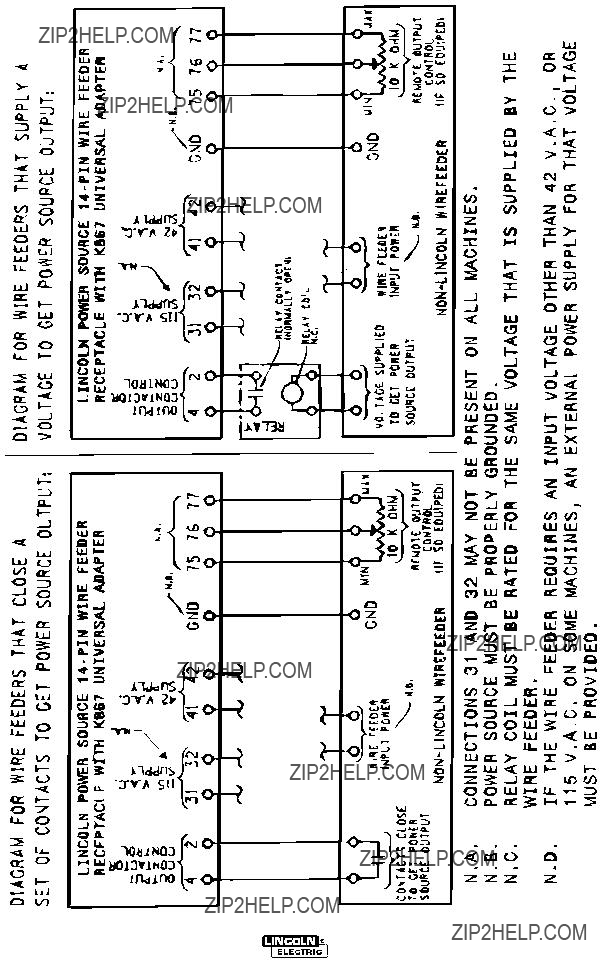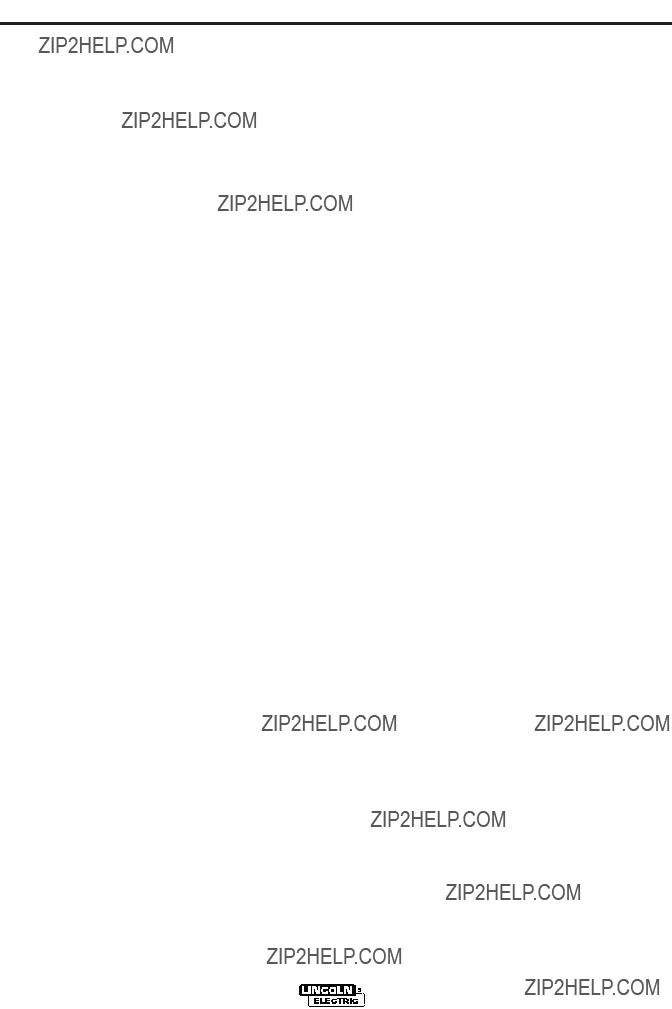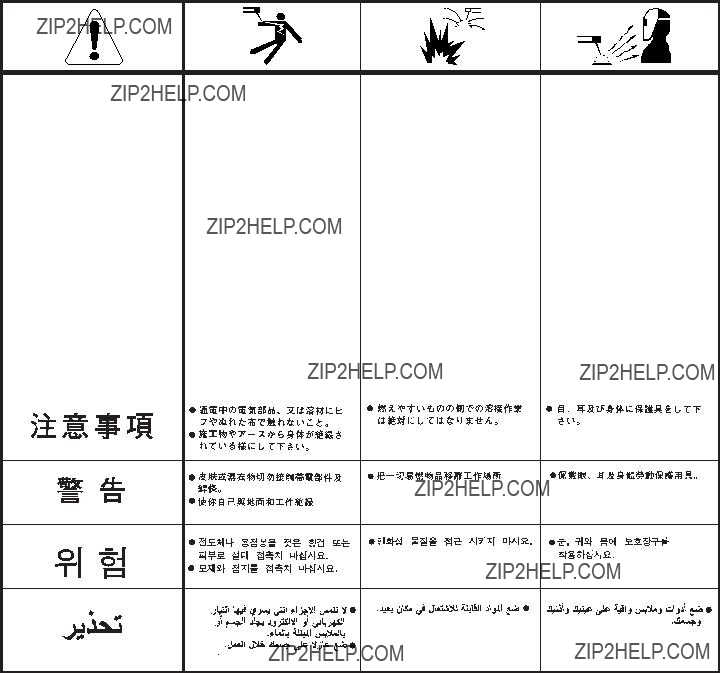Safety Depends on You
Lincoln arc welding and cutting equipment is designed and built with safety in mind. However, your overall safety can be increased by proper installation ... and thought- ful operation on your part. DO
NOT INSTALL, OPERATE OR
REPAIR THIS EQUIPMENT
WITHOUT READING THIS
MANUAL AND THE SAFETY
PRECAUTIONS CONTAINED THROUGHOUT. And, most importantly, think before you act and be careful.
Date of Purchase:
Serial Number:
Code Number:
Model:
Where Purchased:
OPERATOR???S MANUAL
Copyright ?? 2002 Lincoln Global Inc.
??? World's Leader in Welding and Cutting Products ???
??? Sales and Service through Subsidiaries and Distributors Worldwide ???
Cleveland, Ohio 44117-1199 U.S.A. TEL: 216.481.8100 FAX: 216.486.1751 WEB SITE: www.lincolnelectric.com
 WARNING
WARNING
CALIFORNIA PROPOSITION 65 WARNINGS
Diesel engine exhaust and some of its constituents are known to the State of California to cause can- cer, birth defects, and other reproductive harm.
The Above For Diesel Engines
The engine exhaust from this product contains chemicals known to the State of California to cause cancer, birth defects, or other reproductive harm.
The Above For Gasoline Engines
ARC WELDING CAN BE HAZARDOUS. PROTECT YOURSELF AND OTHERS FROM POSSIBLE SERIOUS INJURY OR DEATH.
KEEP CHILDREN AWAY. PACEMAKER WEARERS SHOULD CONSULT WITH THEIR DOCTOR BEFORE OPERATING.
Read and understand the following safety highlights. For additional safety information, it is strongly recommended that you purchase a copy of ???Safety in Welding & Cutting - ANSI Standard Z49.1??? from the American Welding Society, P.O. Box 351040, Miami, Florida 33135 or CSA Standard W117.2-1974. A Free copy of ???Arc Welding Safety??? booklet E205 is available from the Lincoln Electric Company, 22801 St. Clair Avenue, Cleveland, Ohio 44117-1199.
BE SURE THAT ALL INSTALLATION, OPERATION, MAINTENANCE AND REPAIR PROCEDURES ARE
PERFORMED ONLY BY QUALIFIED INDIVIDUALS.
FOR ENGINE powered equipment.
1.a. Turn the engine off before troubleshooting and maintenance work unless the maintenance work requires it to be running.
____________________________________________________
1.b.Operate engines in open, well-ventilated areas or vent the engine exhaust fumes
outdoors.
____________________________________________________
1.c. Do not add the fuel near an open flame welding arc or when the engine is running.
Stop the engine and allow it to cool before refueling to prevent spilled fuel from vaporiz- ing on contact with hot engine parts and igniting. Do not spill fuel when filling tank. If fuel is spilled, wipe it up and do not start engine until fumes have been eliminated.
____________________________________________________
1.d. Keep all equipment safety guards, covers and devices in position and in good repair.Keep hands, hair, clothing and tools away from V-belts, gears, fans and all other moving parts when starting, operating or repairing equipment.
____________________________________________________
1.e. In some cases it may be necessary to remove safety guards to perform required maintenance. Remove guards only when necessary and replace them when the maintenance requiring their removal is complete. Always use the greatest care when working near moving parts.
___________________________________________________
1.f. Do not put your hands near the engine fan.
Do not attempt to override the governor or idler by pushing on the throttle control rods while the engine is running.
___________________________________________________
1.g. To prevent accidentally starting gasoline engines while turning the engine or welding generator during maintenance work, disconnect the spark plug wires, distributor cap or magneto wire as appropriate.
1.h. To avoid scalding, do not remove the radiator pressure cap when the engine is hot.
ELECTRIC AND
MAGNETIC FIELDS may be dangerous
2.a. Electric current flowing through any conductor causes localized Electric and Magnetic Fields (EMF). Welding current creates EMF fields around welding cables and welding machines
2.b. EMF fields may interfere with some pacemakers, and welders having a pacemaker should consult their physician before welding.
2.c. Exposure to EMF fields in welding may have other health effects which are now not known.
2.d. All welders should use the following procedures in order to minimize exposure to EMF fields from the welding circuit:
2.d.1. Route the electrode and work cables together - Secure them with tape when possible.
2.d.2. Never coil the electrode lead around your body.
2.d.3. Do not place your body between the electrode and work cables. If the electrode cable is on your right side, the work cable should also be on your right side.
2.d.4. Connect the work cable to the workpiece as close as possible to the area being welded.
2.d.5. Do not work next to welding power source.
Mar ???95
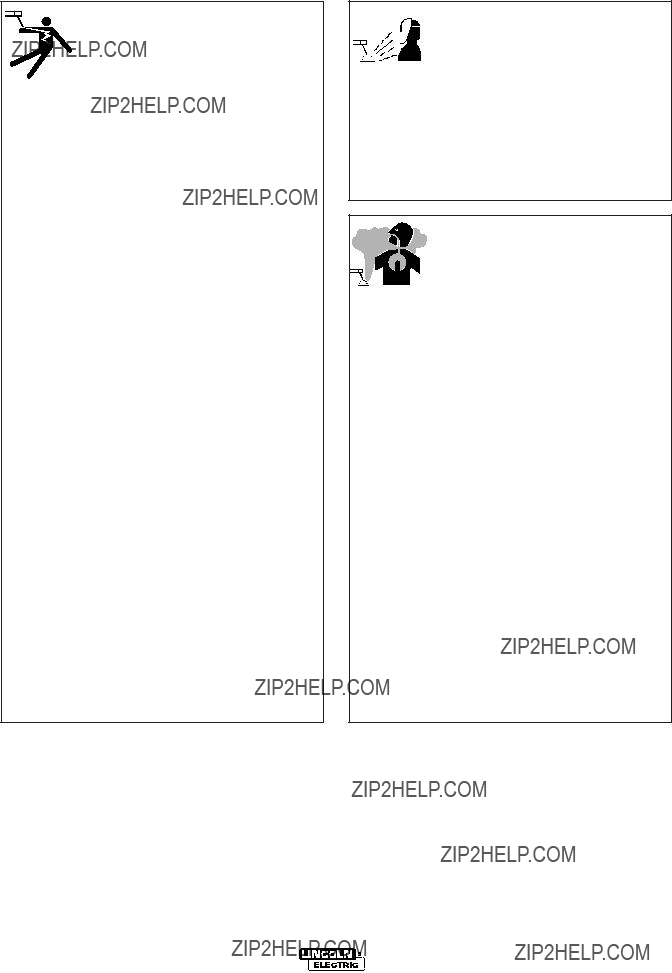
ELECTRIC SHOCK can kill.
3.a. The electrode and work (or ground) circuits are electrically ???hot??? when the welder is on. Do not touch these ???hot??? parts with your bare skin or wet clothing. Wear dry, hole-free
gloves to insulate hands.
3.b. Insulate yourself from work and ground using dry insulation. Make certain the insulation is large enough to cover your full area of physical contact with work and ground.
In addition to the normal safety precautions, if welding must be performed under electrically hazardous conditions (in damp locations or while wearing wet clothing; on metal structures such as floors, gratings or scaffolds; when in cramped positions such as sitting, kneeling or lying, if there is a high risk of unavoidable or accidental contact with the workpiece or ground) use the following equipment:
???Semiautomatic DC Constant Voltage (Wire) Welder.
???DC Manual (Stick) Welder.
???AC Welder with Reduced Voltage Control.
3.c. In semiautomatic or automatic wire welding, the electrode, electrode reel, welding head, nozzle or semiautomatic welding gun are also electrically ???hot???.
3.d. Always be sure the work cable makes a good electrical connection with the metal being welded. The connection should be as close as possible to the area being welded.
3.e. Ground the work or metal to be welded to a good electrical (earth) ground.
3.f. Maintain the electrode holder, work clamp, welding cable and welding machine in good, safe operating condition. Replace damaged insulation.
3.g. Never dip the electrode in water for cooling.
3.h. Never simultaneously touch electrically ???hot??? parts of electrode holders connected to two welders because voltage between the two can be the total of the open circuit voltage of both welders.
3.i. When working above floor level, use a safety belt to protect yourself from a fall should you get a shock.
3.j. Also see Items 6.c. and 8.
ARC RAYS can burn.
4.a. Use a shield with the proper filter and cover plates to protect your eyes from sparks and the rays of the arc when welding or observing open arc welding. Headshield and filter lens should conform to ANSI Z87. I standards.
4.b. Use suitable clothing made from durable flame-resistant material to protect your skin and that of your helpers from the arc rays.
4.c. Protect other nearby personnel with suitable, non-flammable screening and/or warn them not to watch the arc nor expose themselves to the arc rays or to hot spatter or metal.
FUMES AND GASES can be dangerous.
5.a. Welding may produce fumes and gases hazardous to health. Avoid breathing these fumes and gases.When welding, keep your head out of the fume. Use enough ventilation and/or exhaust at the arc to keep
fumes and gases away from the breathing zone. When
welding with electrodes which require special ventilation such as stainless or hard facing (see instructions on container or MSDS) or on lead or cadmium plated steel and other metals or coatings which produce highly toxic fumes, keep exposure as low as possible and below Threshold Limit Values (TLV) using local exhaust or mechanical ventilation. In confined spaces or in some circumstances, outdoors, a respirator may be required. Additional precautions are also required when welding on galvanized steel.
5.b. Do not weld in locations near chlorinated hydrocarbon vapors coming from degreasing, cleaning or spraying operations.
The heat and rays of the arc can react with solvent vapors to form phosgene, a highly toxic gas, and other irritating products.
5.c. Shielding gases used for arc welding can displace air and cause injury or death. Always use enough ventilation, especially in confined areas, to insure breathing air is safe.
5.d. Read and understand the manufacturer???s instructions for this equipment and the consumables to be used, including the material safety data sheet (MSDS) and follow your employer???s safety practices. MSDS forms are available from your welding distributor or from the manufacturer.
5.e. Also see item 1.b.
Mar ???95
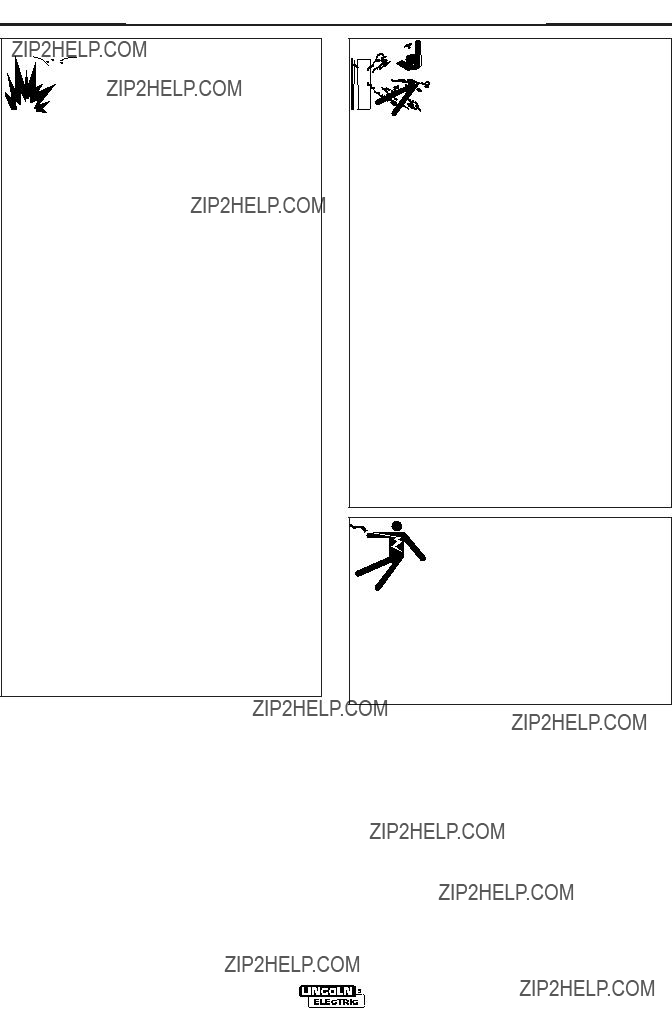

 WELDING SPARKS can
WELDING SPARKS can 
 cause fire or explosion.
cause fire or explosion.
6.a. Remove fire hazards from the welding area.
If this is not possible, cover them to prevent the welding sparks from starting a fire. Remember that welding sparks and hot
materials from welding can easily go through small cracks and openings to adjacent areas. Avoid welding near hydraulic lines. Have a fire extinguisher readily available.
6.b. Where compressed gases are to be used at the job site, special precautions should be used to prevent hazardous situations. Refer to ???Safety in Welding and Cutting??? (ANSI
Standard Z49.1) and the operating information for the equipment being used.
6.c. When not welding, make certain no part of the electrode circuit is touching the work or ground. Accidental contact can cause overheating and create a fire hazard.
6.d. Do not heat, cut or weld tanks, drums or containers until the proper steps have been taken to insure that such procedures will not cause flammable or toxic vapors from substances inside. They can cause an explosion even though they have been ???cleaned???. For information, purchase ???Recommended Safe Practices for the Preparation for Welding and Cutting of Containers and Piping That Have Held Hazardous
Substances???, AWS F4.1 from the American Welding Society
(see address above).
6.e. Vent hollow castings or containers before heating, cutting or welding. They may explode.
6.f. Sparks and spatter are thrown from the welding arc. Wear oil free protective garments such as leather gloves, heavy shirt, cuffless trousers, high shoes and a cap over your hair. Wear ear plugs when welding out of position or in confined places.
Always wear safety glasses with side shields when in a welding area.
6.g. Connect the work cable to the work as close to the welding area as practical. Work cables connected to the building framework or other locations away from the welding area increase the possibility of the welding current passing through lifting chains, crane cables or other alternate cir- cuits. This can create fire hazards or overheat lifting chains or cables until they fail.
6.h. Also see item 1.c.


 CYLINDER may explode
CYLINDER may explode 





 if damaged.
if damaged.
7.a. Use only compressed gas cylinders
containing the correct shielding gas for the process used and properly operating regulators designed for the gas and
pressure used. All hoses, fittings, etc. should be suitable for the application and maintained in good condition.
7.b. Always keep cylinders in an upright position securely chained to an undercarriage or fixed support.
7.c. Cylinders should be located:
???Away from areas where they may be struck or subjected to physical damage.
???A safe distance from arc welding or cutting operations and any other source of heat, sparks, or flame.
7.d. Never allow the electrode, electrode holder or any other electrically ???hot??? parts to touch a cylinder.
7.e. Keep your head and face away from the cylinder valve outlet when opening the cylinder valve.
7.f. Valve protection caps should always be in place and hand tight except when the cylinder is in use or connected for use.
7.g. Read and follow the instructions on compressed gas cylinders, associated equipment, and CGA publication P-l, ???Precautions for Safe Handling of Compressed Gases in
Cylinders,??? available from the Compressed Gas Association 1235 Jefferson Davis Highway, Arlington, VA 22202.
FOR ELECTRICALLY powered equipment.
8.a. Turn off input power using the disconnect switch at the fuse box before working on the equipment.
8.b. Install equipment in accordance with the U.S. National Electrical Code, all local codes and the manufacturer???s recommendations.
8.c. Ground the equipment in accordance with the U.S. National Electrical Code and the manufacturer???s recommendations.
Mar ???95
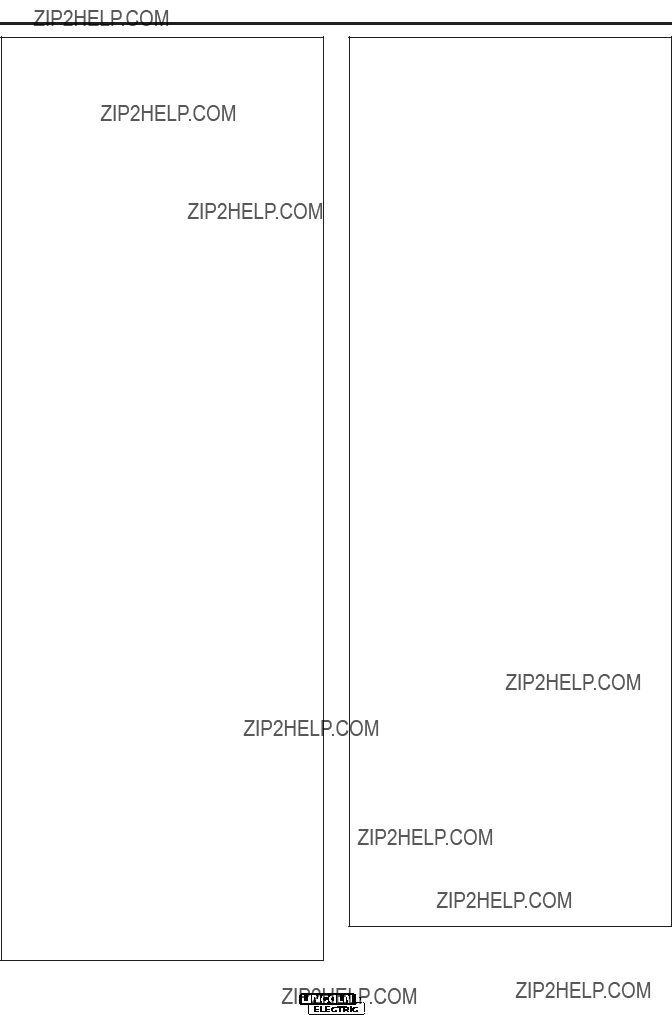
PR??CAUTIONS DE S??RET??
Pour votre propre protection lire et observer toutes les instruc- tions et les pr??cautions de s??ret?? specifiques qui parraissent dans ce manuel aussi bien que les pr??cautions de s??ret?? g??n??rales suivantes:
S??ret?? Pour Soudage A L???Arc
1.Protegez-vous contre la secousse ??lectrique:
a.Les circuits ?? l?????lectrode et ?? la pi??ce sont sous tension quand la machine ?? souder est en marche. Eviter toujours tout contact entre les parties sous tension et la peau nue ou les v??tements mouill??s. Porter des gants secs et sans trous pour isoler les mains.
b.Faire tr??s attention de bien s???isoler de la masse quand on soude dans des endroits humides, ou sur un plancher metallique ou des grilles metalliques, principalement dans les positions assis ou couch?? pour lesquelles une grande partie du corps peut ??tre en contact avec la
masse.
c.Maintenir le porte-??lectrode, la pince de masse, le c??ble de soudage et la machine ?? souder en bon et s??r ??tat defonctionnement.
d.Ne jamais plonger le porte-??lectrode dans l???eau pour le refroidir.
e.Ne jamais toucher simultan??ment les parties sous tension des porte-??lectrodes connect??s ?? deux machines ?? soud- er parce que la tension entre les deux pinces peut ??tre le total de la tension ?? vide des deux machines.
f.Si on utilise la machine ?? souder comme une source de courant pour soudage semi-automatique, ces precautions pour le porte-??lectrode s???applicuent aussi au pistolet de soudage.
2.Dans le cas de travail au dessus du niveau du sol, se pro- t??ger contre les chutes dans le cas ou on recoit un choc. Ne jamais enrouler le c??ble-??lectrode autour de n???importe quelle partie du corps.
3.Un coup d???arc peut ??tre plus s??v??re qu???un coup de soliel, donc:
a.Utiliser un bon masque avec un verre filtrant appropri??
ainsi qu???un verre blanc afin de se prot??ger les yeux du rayonnement de l???arc et des projections quand on soude ou quand on regarde l???arc.
b.Porter des v??tements convenables afin de prot??ger la peau de soudeur et des aides contre le rayonnement de l???arc.
c.Prot??ger l???autre personnel travaillant ?? proximit?? au
soudage ?? l???aide d?????crans appropri??s et non-inflamma- bles.
4.Des gouttes de laitier en fusion sont ??mises de l???arc de soudage. Se prot??ger avec des v??tements de protection libres de l???huile, tels que les gants en cuir, chemise ??paisse, pantalons sans revers, et chaussures montantes.
5.Toujours porter des lunettes de s??curit?? dans la zone de soudage. Utiliser des lunettes avec ??crans lateraux dans les zones o?? l???on pique le laitier.
6.Eloigner les mat??riaux inflammables ou les recouvrir afin de pr??venir tout risque d???incendie d?? aux ??tincelles.
7.Quand on ne soude pas, poser la pince ?? une endroit isol?? de la masse. Un court-circuit accidental peut provoquer un ??chauffement et un risque d???incendie.
8.S???assurer que la masse est connect??e le plus pr??s possible de la zone de travail qu???il est pratique de le faire. Si on place la masse sur la charpente de la construction ou d???autres endroits ??loign??s de la zone de travail, on augmente le risque de voir passer le courant de soudage par les chaines de lev- age, c??bles de grue, ou autres circuits. Cela peut provoquer des risques d???incendie ou d???echauffement des chaines et des c??bles jusqu????? ce qu???ils se rompent.
9.Assurer une ventilation suffisante dans la zone de soudage. Ceci est particuli??rement important pour le soudage de t??les galvanis??es plomb??es, ou cadmi??es ou tout autre m??tal qui produit des fume??s toxiques.
10.Ne pas souder en pr??sence de vapeurs de chlore provenant d???op??rations de d??graissage, nettoyage ou pistolage. La chaleur ou les rayons de l???arc peuvent r??agir avec les vapeurs du solvant pour produire du phosg??ne (gas forte- ment toxique) ou autres produits irritants.
11.Pour obtenir de plus amples renseignements sur la s??ret??, voir le code ???Code for safety in welding and cutting??? CSA
Standard W 117.2-1974.
PR??CAUTIONS DE S??RET?? POUR
LES MACHINES ?? SOUDER ??
TRANSFORMATEUR ET ??
REDRESSEUR
1.Relier ?? la terre le chassis du poste conformement au code de l?????lectricit?? et aux recommendations du fabricant. Le dis- positif de montage ou la piece ?? souder doit ??tre branch?? ?? une bonne mise ?? la terre.
2.Autant que possible, I???installation et l???entretien du poste seront effectu??s par un ??lectricien qualifi??.
3.Avant de faires des travaux ?? l???interieur de poste, la debrancher ?? l???interrupteur ?? la boite de fusibles.
4.Garder tous les couvercles et dispositifs de s??ret?? ?? leur
Mar. ???93
v
for selecting a QUALITY product by Lincoln Electric. We want you to take pride in operating this Lincoln Electric Company product
????????? as much pride as we have in bringing this product to you!
Please Examine Carton and Equipment For Damage Immediately
When this equipment is shipped, title passes to the purchaser upon receipt by the carrier. Consequently, Claims for material damaged in shipment must be made by the purchaser against the transportation company at the time the shipment is received.
Please record your equipment identification information below for future reference. This information can be found on your machine nameplate.
Model Name & Number _____________________________________
Code & Serial Number _____________________________________
Date of Purchase _____________________________________
Whenever you request replacement parts for or information on this equipment always supply the information you have recorded above.
Read this Operators Manual completely before attempting to use this equipment. Save this manual and keep it handy for quick reference. Pay particular attention to the safety instructions we have provided for your protection. The level of seriousness to be applied to each is explained below:
 WARNING
WARNING
This statement appears where the information must be followed exactly to avoid serious personal injury or loss of life.
 CAUTION
CAUTION
This statement appears where the information must be followed to avoid minor personal injury or damage to this equipment.
ELECTRIC SHOCK can kill.
???Only qualified personnel shouldPower switch.) perform this installation.
???Turn the input power OFF at the discon- Have a qualified electrician connect the input leads to
nect switch or fuse box before working on this equipment.
???Turn the Power switch on the CV-300 ???OFF??? before connecting or disconnect- ing output cables, wire feeder or remote connections, or other equipment.
L1, L2, and L3 of the input reconnect panel in accor- dance with the National Electrical Code, all local codes, and the connection diagram located on the inside of the right case side. Use a three phase line.
???Do not touch electrically hot parts.
???Always connect the Idealarc CV-300 grounding terminal (located on the welder base near the reconnect panel) to a good electrical earth ground.
SELECT SUITABLE LOCATION
Place the welder where clean cooling air can freely circulate in through the side louvers and out through the rear louvers. Dirt, dust or any foreign material that can be drawn into the welder should be kept at a minimum. Failure to observe these precautions can result in excessive operating temperatures and nuisance shut-downs. Idealarc CV-300 power sources carry an IP23 enclosure rating. They are rated for use in damp, dirty environments subject to occasional falling water such as rain.
STACKING
The CV-300 may be stacked three-high provided the bottom machine is on a stable, hard, level surface. Be sure that the two pins in the roof fit into the slots in the base of the CV-300 above it.
TILTING
Do not place the machine on a surface that is inclined enough to create a risk of the machine falling over.
The frame of the welder must be grounded. A ground terminal marked with the symbol  located on the base of the machine is provided for this purpose. See the National Electrical Code for details on proper grounding methods.
located on the base of the machine is provided for this purpose. See the National Electrical Code for details on proper grounding methods.
Fuse the input circuit with the recommended super lag fuses. Choose an input and grounding wire size according to local codes or use the following table. "Delay type"1 circuit breakers may be used in place of fuses. Using fuses or circuit breakers smaller than recommended may result in "nuisance" tripping from welder inrush currents even if not welding at high cur- rents.
RECOMMENDED INPUT WIRE AND FUSE SIZES
1Also called ???inverse time??? or ???thermal/magnetic??? circuit breakers; circuit breakers which have a delay in tripping action that decreases as the magni- tude of the current increases.

FIELD INSTALLED OPTIONS
For installation of compatible field installed options (see the ACCESSORIES section of this manual and refer to the instructions included with those options.
REQUIRED EQUIPMENT-CONTROL
CABLE CONNECTIONS
Follow the instructions below which are appropriate for the wire feeder that will be used.
LN-7 to CV-300
a)Turn the CV-300 Power switch to the "OFF" posi- tion.
b)Connect the LN-7 control cable to the wire feeder receptacle on the CV-300.
c)See OUTPUT CONNECTIONS for connection of work and electrode cables.
LN-25 to CV-300
a)Turn the CV-300 Power switch to the "OFF" posi- tion.
b)Plug a K484 jumper plug into the CV-300 wire feeder receptacle.
c)See OUTPUT CONNECTIONS for connection of work and electrode cables.
 WARNING
WARNING
The output terminals are energized at all times when the K484 is plugged in.
------------------------------------------------------------------------
LN-742 to CV-300
a)Turn the CV-300 Power switch to the "OFF" posi- tion.
b)Connect the LN-742 control cable to the wire feeder receptacle on the CV-300.
c)See OUTPUT CONNECTIONS for connection of work and electrode cables.
Connection of Remote Control (K857)
NOTE: The K864 Remote Control Adapter is required to install the K857.
Plug the K864 Remote Control Adapter into the power source's 14-pin receptacle. Plug the K857 Remote Control into the 6-pin receptacle of the K864 adapter. If possible, tape the Remote cable to the heavy output leads, so they can protect the smaller Remote cable from damage and abuse.
OUTPUT CONNECTIONS
Output cables must have Magnum Twist-Mate??? plugs for connection to the CV-300. Order K852-95 for con- necting 2/0-3/0 (70-95 mm2) cables. Refer to S18737 for instructions on installing these plugs.
Use the shortest possible cable lengths. See Table A.1 for recommended cable sizes based on length.
Connect the positive output lead to the terminal marked "+". The negative output lead can be hooked to either the low inductance terminal (marked "  ") or the high inductance terminal (marked "
") or the high inductance terminal (marked " 
 ").
").
TABLE A.1
Cable Sizes for Combined Lengths of Copper Electrode and Work Cable
PARALLELING
The CV-300 is not designed to be paralleled with any other power source.
CONNECTION OF AUXILIARY EQUIPMENT
TO THE WIRE FEEDER RECEPTACLE
Occasionally, it may be necessary to make connection to the circuits present in the 14-pin wire feeder recep- tacle. These circuits, such as the auxiliary voltage, contactor, and remote control circuits, may be accessed with a K867 Universal Adapter. This adapter plugs into the receptacle and provides the user with short wire leads for connections. Refer to the instructions provided with the K867, as well as the wiring diagram for the CV-300 power source, for details on making those connections. For your conve- nience, wire feeder connection details are shown in the DIAGRAM section.
NOTE: If you intend to use a standard Lincoln wire feeder, order the appropriate input cable for the specific feeder. It will make all of the con- trol and power connections between the CV- 300 and the wire feeder WITHOUT the need for a K867 Universal Adapter.
OPERATING INSTRUCTIONS
Read and understand this entire section before oper- ating the machine.
GENERAL WARNINGS
SAFETY PRECAUTIONS
 WARNING
WARNING
ELECTRIC SHOCK can kill.
???Do not touch electrically live parts or electrode with skin or wet clothing.
???Insulate yourself from work and ground.
???Always wear dry insulating gloves.
FUMES AND GASES can be dangerous.
??? Keep your head out of fumes.
???Use ventilation or exhaust to remove fumes from breathing zone.
 WELDING SPARKS
WELDING SPARKS 
 can cause fire or explosion
can cause fire or explosion
???Keep flammable material away.
???Do not weld on containers that have held combustibles.
ARC RAYS can burn.
???Wear eye, ear and body protection.
Observe additional Safety Guidelines detailed throughout this manual.

 CAUTION
CAUTION
When using a CV-300 power source with wire feed- ers, there will be a small spark if the electrode con- tacts the work or ground within several seconds after releasing the trigger.
When used with some wire feeders with the electrical trigger interlock in the ON position, the arc might restart if the electrode touches the work or ground during these several seconds.
------------------------------------------------------------------------
GENERAL DESCRIPTION
The CV-300 is a constant voltage DC power source designed for the GMAW process with limited FCAW capability as well. It features an industrial rating of 300 amps, 32 volts, at 100% duty cycle. It complies with the requirements for a NEMA Class I (100) power source.
It is available from the factory in one model only, with no options other than input voltage or frequency.
RECOMMENDED PROCESSES AND
EQUIPMENT
The CV-300 is capable of solid wire welding within the rated output capacity of the machine. It is also capa- ble of welding with the following flux-cored wires: NR- 152, NR-211, NS-3M, NR-203 Ni 1%, and Outershield?? 70 and 71.
The CV-300 is recommended for use with the LN-7, LN-742 and LN-25 wire feeder models.
OPERATIONAL FEATURES AND
CONTROLS
???Two inductance positions: operator can choose the optimum output characteristics.
???Solid State Output Contactor: no noise, no moving parts to wear.
???Digital Voltmeter/Ammeter is standard.
???Power on/off switch.
???42 VAC, 10 amp auxiliary power available for the wire feeder.
???Circuit breaker protected.
???115 VAC, 5 amp auxiliary power available for the wire feeder; circuit breaker protected.
???Magnum Twist-Mate??? output receptacles.
???Single MS-type (14-pin) connection for wire feeder.
???Solid state controls, with line voltage compensation.
???Optional remote control capability.
DESIGN FEATURES
???"Clean" appearance and simple controls -- easy to operate.
???Electronic and thermostatic protection from over- loads.
???Submersion dipping of assembled transformer, choke, and rectifier in special sealing/insulating material gives extra protection against moisture and corrosive atmospheres.
???Microprocessor based Control PC Board has built-in diagnostic routines.
???Compact size, requires only 19" x 26" footprint.
???Modular construction for easy servicing.
???Recessed panels protect output studs and controls. Large safety margins and protective circuits protect rectifiers from transient voltages and high currents.
LIMITATIONS
The CV-300 is intended only for use with the following FCAW electrodes: NR-152, NR-211, NR-203 Ni 1%, NS-3M, Outershield 70 and 71. The machine has been designed primarily for the GMAW process.
POWER SOURCE OPERATION
Be sure the CV-300 is properly installed, and that all accessories are properly hooked up before attempting operation.
DUTY CYCLE
300 Amps, 32 Volts at 100%
400 Amps, 36 Volts at 60%
Duty Cycle is based on operation for a 10 minute period.
CONTROLS AND SETTINGS
All operator controls and adjustments are located on the case front of the CV-300. Refer to Figures B.1, and B.2 and corresponding explanations.
FIGURE B.1 - CONTROL PANEL
D
EC
F G B
A.POWER SWITCH
B.VOLTAGE ADJUSTMENT
C.THERMAL PROTECTION INDICATION LIGHT
D.VOLTS / AMPS SWITCH
E.DIGITAL VOLTMETER / AMMETER
A.POWER SWITCH
-A two-position toggle switch.Controls the input power to the CV-300.
B.VOLTAGE ADJUST
-Controls the CV-300 output voltage.
C.THERMAL PROTECTION INDICATION LIGHT
-Indicates that the protection thermostat has activated. The digital meter will display "E10" when this occurs. When the light turns off, the machine will be capable of supplying welding output power again.
NOTE: Leaving the power switch in the "ON" posi- tion will result in the most rapid cooling.
D.VOLTS/AMPS SWITCH
-Selects either output current or arc voltage to be displayed on the digital meter.
E.DIGITAL VOLTMETER/AMMETER
-Displays the CV-300 output current, or the arc voltage.
H J A
F.42 VOLT CIRCUIT BREAKER
G.115 VOLT CIRCUIT BREAKER
H.LOCAL / REMOTE SWITCH
J.WIRE FEEDER VOLTMETER SWITCH
NOTE: Due to voltage drops in the welding cables and at cable connection points, the actual arc voltage may be lower than that displayed on the voltmeter. Use welding cables of the proper capacity and make sure all connec- tions are tight to minimize this effect.
F. 42 VOLT CIRCUIT BREAKER
-Protects the 42 volt 41-42 circuit in the wire feeder receptacle from overloads and shorts. If this circuit breaker opens, the CV-300 will work normally. However, any equipment powered by the 42 volt circuit will not work.
G. 115 VOLT CIRCUIT BREAKER
-Protects the 115 volt 31-32 circuit in the wire feeder receptacle from overloads and shorts. If this circuit breaker opens, the CV-300 will work normally. However, any equipment powered by the 115 volt circuit will not work.
H. LOCAL/REMOTE SWITCH
-Determines whether the welding voltage is controlled at the CV-300, or controlled remotely by a remote output control (such as a K857).
-This switch selects the polarity of the wire feeder voltmeter, if so equipped. When weld- ing electrode positive (MIG, Outershield and some Innershield processes) set the switch to "+".
-This switch has no effect on the welding polarity. In fact, if the wire feeder being used does not have a voltmeter, the setting of this switch has no effect.
GRAPHIC SYMBOLS THAT APPEAR ON
THIS MACHINE OR IN THIS MANUAL
THERMAL PROTEC-
OFFTION INDICATOR
LIGHT
OUTPUT PANEL CONNECTIONS
FIGURE B.2 - OUTPUT PANEL
-Each connector is a Magnum Twist-Mate???, receptacle. Insert a mating Twist-Mate??? plug, and twist clockwise to secure.
For GMAW processes, and most FCAW processes, the positive output connection goes to the wire feeder. One of the negative output connections goes directly to the work.
A.POSITIVE OUTPUT CONNECTION.
B.LOW INDUCTANCE NEGATIVE CONNECTION.
-The low inductance connection is typically used for short arc welding of mild steel, par- ticularly on thin materials or when using CO2
shielding gas.
-The high inductance connection is more suit- able for short arc welding heavier weldments or when using 75% Argon/25% CO2 shield-
ing gas. This connection produces a softer arc and a flatter bead with more wash-in than the low inductance connection. A spray type transfer is possible with either connection.
D. WIRE FEEDER RECEPTACLE
-14-pin MS style receptacle for wire feeder. Provides connections for auxiliary power, contactor closure, remote output control, wire feeder voltmeter sense lead, and ground.

STARTING THE MACHINE
The power switch at the extreme right side of the con- trol panel energizes the CV-300.
ADJUSTING THE OUTPUT VOLTAGE
USING THE DIGITAL METER
The digital meters in the CV-300 incorporate a voltage pre- set function. This allows the operator to set the desired welding voltage before striking an arc. The digital meters can also display welding current.
To make use of the voltage preset function, the Volts/Amps switch must be in the "Volts" position. Turn the Voltage Adjust knob until the digital meter displays the desired weld- ing voltage. (See below if an external power source remote control is installed.)
When an arc is struck, the digital meter displays the actual welding voltage, as measured at the CV-300 output termi- nals.
NOTE: The arc voltage at the electrode may be as much as two volts different from the CV-300 output terminal voltage. This is due to voltage drops present in the welding cables, cable connections, and welding gun. To minimize these drops, use cables of ade- quate capacity, and make sure all connections are clean and tight. Because of these voltage drops, you may have to preset the CV-300 for a slightly higher welding voltage than your procedure calls for.
To read welding current, set the Volts/Amps switch to the "Amps" position. The welding current will be displayed whenever an arc is struck.
LOCAL/REMOTE SWITCH OPERATION
If voltage control is desired at the CV-300, the Local/Remote switch must be in the "Local" position. The Voltage Adjust on the front panel can be used to adjust the CV-300 output. (The remote control, even if connected, will have no effect if the switch is in the "Local" position).
To use a remote control, such as the K857 (see INSTALLA- TION section), place the Local/Remote switch (see Figure B.1) in the "Remote" position. The remote control now con- trols the output voltage, in the manner described above. This control may be adjusted while welding to change the CV-300 output.
AUXILIARY POWER
42 volt AC auxiliary power, as required for some wire feeders, is available through the wire feeder recepta- cle. A 10 amp circuit breaker protects the 42 volt cir- cuit from overloads.
CV-300 machines can also supply 115 volt AC auxil- iary power through the wire feeder receptacle. A 5 amp circuit breaker protects the 115 volt circuit from overloads.
NOTE: Do not use circuits 2 or 4 for control of auxil- iary loads. (The 2-4 circuit is isolated from the 31-32 and 41-42 circuits.)
 CAUTION
CAUTION
Note that some types of equipment, especially pumps and large motors, have starting currents which are significantly higher than their running current. These higher starting currents may cause the circuit breaker to open. If this situation occurs, the user should refrain from using the CV-300 auxiliary power for that equip- ment.
___________________________________________
OVERLOAD PROTECTION
This welder has thermostatic protection from exces- sive duty cycles, overloads, loss of cooling, and high ambient temperatures. When the welder is subjected to an overload or loss of cooling, a thermostat will open. This condition will be indicated by the illumina- tion of the yellow Thermostatic Protection Light on the case front (see Figure B.1).The fan will continue to run to cool the power source. No welding is possible until the machine is allowed to cool and the Thermostatic Protection Light goes out.

FACTORY INSTALLED
OPTIONS/ACCESSORIES
There are no factory installed options/accessories on the CV-300.
FIELD INSTALLED OPTIONS
REMOTE VOLTAGE CONTROL (K857)
The K857 consists of a control box with 25 feet (7.6 m) of four conductor cable. Installation of a K857 Remote Voltage Control in the CV-300 requires a K864 Remote Control Adapter. Refer to the instruc- tions provided with the K857 for hookup to the CV- 300. When properly connected, and with the CV-300 Local-Remote Switch in the "Remote" position, the K857 functions the same as the CV-300 Voltage Adjust control, enabling minimum to maximum output voltage adjustment of the CV-300.
UNDERCARRIAGE (K835)
Includes front casters, a handle, a bracket, and a rear wheeled platform that is capable of carrying one gas cylinder. The CV-300 lifting eye is not functional with the K835 undercarriage installed.
TWO-CYLINDER UNDERCARRIAGE (K874)
Platform type undercarriage that can accommodate either one or two gas bottles, or one gas bottle and a Magnum water cooler. The CV-300 lifting eye is not functional when the K874 undercarriage is installed.
WIRE FEEDER SWIVEL MOUNT (K178-1)
Allows an LN-7 or LN-742 to be securely mounted on the roof of a CV-300.
UNIVERSAL ADAPTER (K867)
Provides a means of connecting auxiliary equipment to the wire feeder receptacle on the CV-300 power source. Consists of a 14-pin MS-type (Amphenol) plug with 8 inch (0.2 meter) long flex leads, one for each circuit present in the wire feeder receptacle. Not required when using a standard wire feeder input cable, such as a K480, with a Lincoln wire feeder.
COMPATIBLE LINCOLN EQUIPMENT
The CV-300 is intended for use with the LN-7, LN-742, and LN-25 wire feed units. Use the Cables / Kits listed below to make connection easily:

SAFETY PRECAUTIONS
 WARNING
WARNING
ELECTRIC SHOCK can kill.
???Only qualified personnel should perform this maintenance.
???Turn the input power OFF at the disconnect switch or fuse box before working on this equipment.
???Do not touch electrically hot parts.
GENERAL MAINTENANCE
1.The fan motor has sealed bearings which require no service.
2.In extremely dusty locations, dirt may clog the air channels causing the welder to run hot with prema- ture tripping of thermal protection. Blow out the welder with low pressure air at regular intervals to eliminate excessive dirt and dust build-up on inter- nal parts.
MACHINE AND CIRCUIT PROTECTION
The CV-300 Control PC Board has built-in diagnostic routines to alert the operator when trouble exists. When a trouble condition occurs, the CV-300 meter will display an error code, in the form "EXX", where "XX" refers to a specific error. See TROU- BLESHOOTING section for an explanation of the error codes.
The power source is thermostatically protected against overload or insufficient cooling. If the machine is overloaded, the thermostat will open, thermal pro- tection indicator light will turn on, and the output will be zero. The fan will continue to run and auxiliary power will still be available. The thermostat will remain open until the machine cools, at which time it will close and the output will again be available.
The CV-300 is electronically protected against over- loads and accidental short circuits. The overload pro- tection circuit automatically reduces the output current to a safe value when an overload is detected. If the circuitry senses a short circuit, it will shut off the CV- 300 output. The short circuit protection circuit can be reset by turning the CV-300 Power switch OFF for at least 10 seconds. Remove the short before turning the Power switch ON again.
HOW TO USE TROUBLESHOOTING GUIDE
 WARNING
WARNING
Service and Repair should only be performed by Lincoln Electric Factory Trained Personnel. Unauthorized repairs performed on this equipment may result in danger to the technician and machine operator and will invalidate your factory warranty. For your safety and to avoid Electrical Shock, please observe all safety notes and precautions detailed throughout this manual.
__________________________________________________________________________
This Troubleshooting Guide is provided to help you locate and repair possible machine malfunctions. Simply follow the three-step procedure listed below.
Step 1. LOCATE PROBLEM (SYMPTOM).
Look under the column labeled ???PROBLEM (SYMP- TOMS)???. This column describes possible symptoms that the machine may exhibit. Find the listing that best describes the symptom that the machine is exhibiting.
Step 2. POSSIBLE CAUSE.
The second column labeled ???POSSIBLE CAUSE??? lists the obvious external possibilities that may contribute to the machine symptom.
Step 3. RECOMMENDED COURSE OF ACTION
This column provides a course of action for the Possible Cause, generally it states to contact your local Lincoln Authorized Field Service Facility.
If you do not understand or are unable to perform the Recommended Course of Action safely, contact your local Lincoln Authorized Field Service Facility.
 CAUTION
CAUTION
If for any reason you do not understand the test procedures or are unable to perform the tests/repairs safely, contact your Local Lincoln Authorized Field Service Facility for technical troubleshooting assistance before you proceed.
Observe all Safety Guidelines detailed throughout this manual
BUILT-IN DIAGNOSTIC ROUTINES AND ERROR CODES
The CV-300 Meter PC Board displays error codes when certain trouble conditions exist. The error codes, trouble conditions, and possible remedies are listed below.
If, after attempting the remedies listed above, the error condition still exists, the problem may be with the wiring in the following areas: the shunt (leads 218 and 219), or voltage feedback (leads 213B, 214B and 224B).
 CAUTION
CAUTION
If for any reason you do not understand the test procedures or are unable to perform the tests/repairs safely, contact your Local Lincoln Authorized Field Service Facility for technical troubleshooting assistance before you proceed.
CV-300
MACHINE TROUBLESHOOTING GUIDE
Not all trouble conditions can be recognized by the PC board, and displayed as error codes. The following guide covers most other trouble conditions.
2.Electrode or work lead loose or broken.
3.Defective PC Board.
4.Protective circuits operating due to output short circuit.
5.If using an LN-25, K484 jumper plug kit not making connection between 2 & 4 in wire feeder receptacle.
6.If welding with 1/16" aluminum
wire and machine is flashing E00. If all recommended possible areas
of misadjustment have been checked and the problem persists,
Contact your local Lincoln
Authorized Field Service Facility.
Machine has minimum output and no 1. Voltage Control misconnected. control.
Machine has low output and no con- 1. Open in feedback circuitry. trol.
2.Faulty PC Board.
3.Voltage Adjust potentiometer circuit open (lead 75).
 CAUTION
CAUTION
If for any reason you do not understand the test procedures or are unable to perform the tests/repairs safely, contact your Local Lincoln Authorized Field Service Facility for technical troubleshooting assistance before you proceed.
CV-300
 CAUTION
CAUTION
If for any reason you do not understand the test procedures or are unable to perform the tests/repairs safely, contact your Local Lincoln Authorized Field Service Facility for technical troubleshooting assistance before you proceed.
CV-300
 CAUTION
CAUTION
If for any reason you do not understand the test procedures or are unable to perform the tests/repairs safely, contact your Local Lincoln Authorized Field Service Facility for technical troubleshooting assistance before you proceed.
CV-300
 CAUTION
CAUTION
If for any reason you do not understand the test procedures or are unable to perform the tests/repairs safely, contact your Local Lincoln Authorized Field Service Facility for technical troubleshooting assistance before you proceed.
CV-300

Procedure for Replacing PC Boards
 WARNING
WARNING
ELECTRIC SHOCK can kill.
???Have a qualified individual install and service this equipment.
???Turn the power source input power off at the disconnect switch before work- ing on this equipment.
???Do not touch electrically hot parts.
---------------------------------------------------------------------
Before replacing a PC board which is suspected of being defective, visually inspect the PC board in ques- tion for any electrical or mechanical damage to any of its components and conductors on the back of the board.
a.If there is no visible damage to the PC board, install a new one and see if this remedies the prob- lem. If the problem is remedied, reinstall the old PC board to see if the problem still exists. If it does no longer exist with old PC board:
1.Check the PC board harness connector pins for corrosion, contamination, or looseness.
2.Check leads in the plug harness for loose or intermittent connection.
b.If PC board is visibly damaged electrically, before possibly subjecting the new PC board to the same cause of failure, check for possible shorts, opens, or grounds caused by:
1.Frayed or pinched lead insulation.
2.Poor lead termination, such as a poor contact or a short to adjacent connection or surface.
3.Shorted or open motor leads, or other external leads.
4.Foreign matter or interference behind the PC boards.
c.If PC board is visibly damaged mechanically, inspect for cause, then remedy before installing a replacement PC board.
If there is damage to the PC board or if replacing PC board corrects problem, return it to the local Lincoln Electric Field Service Shop.
PC BOARD TROUBLESHOOTING
PROCEDURES
CONTROL PC BOARD
The Control PC Board controls all machine functions including the thermal protection indicator light and the Meter PC Board. Most problems, if not caused by faulty wiring machine misuse, will stem from a faulty Control PC Board.
Perform the following diagnostic procedure before replacing the Control PC Board.
1.Turn off the input power at the fuse box.
2.Check for loose connections in the PC Board plugs, particularly J3.
3.Disconnect the J3 plug from the Control PC Board. Measure the resistance between the following wire terminals in the plug:
A)Between wire #200 and wire #201.
B)Between wire #202 and wire #203.
Both of these resistances should be less than 1 ohm.
If these resistances are not less than 1 ohm, check the wiring back to the main transformer.
If these voltages are less than 1 ohm, refer to "Procedure for Replacing PC Boards."
METER PC BOARD
When the Meter PC Board malfunctions, first determine if the rest of the machine functions correctly. If so, then the problem is in either the harness between the meter and control boards, or in the meter board itself. Refer to "Procedure for Replacing PC Boards". As a last resort, the Control PC Board may have to be replaced.
 CAUTION
CAUTION
If for any reason you do not understand the test procedures or are unable to perform the tests/repairs safely, contact your Local Lincoln Authorized Field Service Facility for technical troubleshooting assistance before you proceed.
CV-300
OUTPUT VOLTAGE
The open circuit voltage of the machine should be 10 to 43 volts. If any other condition exists, refer to the Troubleshooting Guide.
FAULT PROTECTION OPERATION
The overload protection circuit on the PC Board will cause the CV-300 meter to display "E60". This pro- tection circuit will reset itself automatically. The short circuit protection circuit will cause the meter to display "E00". The CV-300 power switch must be turned "OFF" and then "ON" to return the machine to normal output.
CHECKING SNUBBER CIRCUIT
In case of an SCR malfunction or failure, the snubber assembly should be checked. Disconnect the input power to the CV-300 at the fuse box and remove the right side of the machine.
1.Visually inspect the snubber PC Board assembly (located below the Control PC board on the case front for overheated components or damaged compo- nents).
OPTIONAL K857 REMOTE CONTROL
CHECK
Disconnect the remote output control and connect an ohm- meter between pins C and B and rotate the rheostat in the remote control. The resistance reading should go from zero to 10K ohms. Repeat with ohmmeter across A and B with the same results. Connect ohmmeter across A and C. The reading should be 10K ohms. A lower reading will indicate a shorted or partially shorted rheostat. A very high reading will indicate an open rheostat. In either of the last two cases, replace the rheostat.
 CAUTION
CAUTION
If for any reason you do not understand the test procedures or are unable to perform the tests/repairs safely, contact your Local Lincoln Authorized Field Service Facility for technical troubleshooting assistance before you proceed.
CV-300
WIRING DIAGRAM CV-300 (60Hz)
 +
+
300-CV
*TO A SYSTEM GROUND PER
NATIONAL ELECTRICAL CODE.
208/230/460 INPUT VOLTAGES
204D 
204C
SCR1  204A
204A 


s
 12V O2 TOP
12V O2 TOP
s
12V O1 TOP
31
 42V O1 TOP
42V O1 TOP

 42A
42A 
 42
42
CB1 10A
CIRCUIT
sBREAKER
N.A. WIRING VIEWED FROM REAR OF POTENTIOMETER
N.B. TAP LEADS A, B, AND C APPEAR ON THE TOP PRIMARY COILS
NOTE: This diagram is for reference only. It may not be accurate for all machines covered by this manual. The specific diagram for a particular code is pasted inside the machine on one of the enclosure panels. If the diagram is illegible, write to the Service Department for a replacement. Give the equipment code number..
WARNING
ELECTRIC
SHOCK
CAN KILL
 Turn off input power to the Welding Power Source using the disconnect switch at the fuse box Before connecting the wire feeder.
Turn off input power to the Welding Power Source using the disconnect switch at the fuse box Before connecting the wire feeder.
Only qualified persons should install, use or
service this machine.
300-CV
WARNING
 Turn off input power to the Welding Power Source using the disconnect switch at the fuse box Before connecting the wire feeder.
Turn off input power to the Welding Power Source using the disconnect switch at the fuse box Before connecting the wire feeder.
N.A. WELDING CABLE MUST BE SIZED FOR CURRENT AND DUTY CYCLE OF APPLICATION.
N.B. DIAGRAM SHOWS ELECTRODE POSITIVE. TO CHANGE POLARITY, TURN POWER "OFF",
REVERSE ELECTRODE AND WORK CABLES AT POWER SOURCE.
N.C. INSULATE EACH UNUSED LEAD INDIVIDUALLY.
N.D. FOR WIRE FEEDERS THAT RETURN A SIGNAL FOR WELDING OUTPUT, USE ISOLATION RELAY TO CLOSE LEADS 2 & 4.
N.E. REFER TO POWER SOURCE INSTRUCTION MANUAL FOR MAXIMUM AUXILIARY
CURRENT DRAW.
N.F. NOT PRESENT ON ALL MACHINES
WARNING
ELECTRIC
SHOCK
CAN KILL
CV/CV-I
 Turn off input power to the Welding Power Source using the disconnect switch at the fuse box Before connecting the wire feeder.
Turn off input power to the Welding Power Source using the disconnect switch at the fuse box Before connecting the wire feeder.
Only qualified persons should install, use or
service this machine.
LN-7
WIRE
FEEDER
K291 OR K404
INPUT CABLE
K775 OPTIONAL
REMOTE CONTROL
WARNING
ELECTRIC
SHOCK
CAN KILL
 Turn off input power to the Welding Power Source using the disconnect switch at the fuse box Before connecting the wire feeder.
Turn off input power to the Welding Power Source using the disconnect switch at the fuse box Before connecting the wire feeder.
Only qualified persons should install, use or
service this machine.
300-CV
N.C.


 N.D.
N.D.

 TO WORK
TO WORK
ELECTRODE CABLE
N.A. WELDING CABLE MUST BE SIZED FOR CURRENT AND DUTY CYCLE OF APPLICATION.
N.B. DIAGRAM SHOWS ELECTRODE POSITIVE. TO CHANGE POLARITY, TURN POWER "OFF",
REVERSE ELECTRODE AND WORK CABLES AT POWER SOURCE.
N.C. USE OF THE K857 REMOTE CONTROL REQUIRES INSTALLATION OF A K864 REMOTE
CONTROL ADAPTER TO THE 14 PIN AMPHENOL OF THE POWER SOURCE.
N.D. CONNECT THE K484 JUMPER PLUG DIRECTLY TO THE 14 PIN AMPHENOL
OF THE POWER SOURCE IF NO REMOTE CONTROL IS USED.
IF USING A K857 REMOTE CONTROL,CONNECT THE K484 JUMPER PLUG
TO THE 14 PIN AMPHENOL OF THE K864 REMOTE CONTROL ADAPTER.
THE POWER SOURCE WELDING TERMINALS ARE ALWAYS "HOT" WHEN THE K484 JUMPER
CV/CV-I POWER SOURCE TO LN-25 WITH K444-1 OPTION CONNECTION DIAGRAM
WARNING
ELECTRIC
SHOCK
CAN KILL
 Turn off input power to the Welding Power Source using the disconnect switch at the fuse box Before connecting the wire feeder.
Turn off input power to the Welding Power Source using the disconnect switch at the fuse box Before connecting the wire feeder.
Only qualified persons should install, use or
service this machine.
300-CV
+ -
N.A. WELDING CABLE MUST BE SIZED FOR CURRENT AND DUTY CYCLE OF APPLICATION.
N.B. DIAGRAM SHOWS ELECTRODE POSITIVE. TO CHANGE POLARITY, TURN POWER "OFF",
REVERSE ELECTRODE AND WORK CABLES AT POWER SOURCE, SWITCH LN-25 POLARITY SWITCH.
N.C. CONNECT THE K484 JUMPER PLUG TO THE 14 PIN RECEPTACLE OF THE
K864 REMOTE CONTROL ADAPTER. CONNECT THE 6 PIN PLUG FROM THE LN-25 (WITH K444-1 OPTION) TO THE 6 PIN RECEPTACLE OF THE K864
REMOTE CONTROL ADAPTER. SWITCH THE POWER SOURCE "LOCAL/REMOTE" SWITCH TO REMOTE.
N.D. THE POWER SOURCE TERMINALS ARE ALWAYS "HOT" WHEN THE K484 JUMPER
PLUG KIT IS INSTALLED.
6-18-93
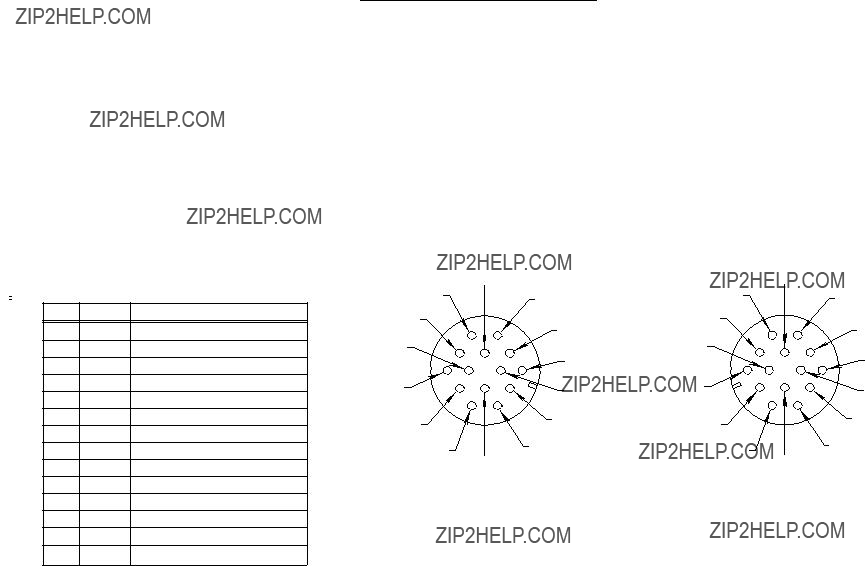
300-CV
INSTALLATION INSTRUCTIONS
THIS CONNECTOR IS MEANT TO BE USED WITH LINCOLN POWER SOURCES WHICH HAVE A 14-PIN
WIRE FEEDER RECEPTACLE. IT IS DESIGNED TO ALLOW THE USER TO MAKE CONNECTIONS
TO ANY OF THE 14 CIRCUITS PRESENT IN THE WIRE FEEDER RECEPTACLE.
CONSULT THE WIRING DIAGRAM OF THE POWER SOURCE AND WIRE FEEDER THIS ADAPTER WILL BE USED WITH.
NOT ALL CIRCUITS ARE PRESENT IN EVERY POWER SOURCE, NOR ARE THEY REQUIRED FOR PROPER WIRE FEEDER OPERATION.
1. TURN THE POWER SWITCH OF THE WELDING POWER SOURCE OFF BEFORE INSTALLING
THIS ADAPTER TO WIRE FEEDER CABLE.
2.CONSULT THE APPROPRIATE EQUIPMENT WIRING DIAGRAMS FOR THE CONNECTIONS TO UNIVERSAL ADAPTER.
THE STANDARD CONNECTOR PIN DESIGNATIONS AND FUNCTIONS ARE SHOWN BELOW.
NOTE: 115V AC (31, 32), 42V AC (41, 42), 24V AC (SPARE) AND TRIGGER CIRCUIT (2, 4)
MAY OR MAY NOT BE ISOLATED, INDEPENDENT CIRCUITS INSIDE THE WELDER.
3.USE LUG, CRIMP SPLICE OR SOLDER CONNECTIONS AS REQUIRED AND INSULATE EACH USED AND UNUSED LEAD
IN THE UNIVERSAL ADAPTER. THE INSULATING METHOD MUST BE RATED FOR 120V AC OR GREATER.
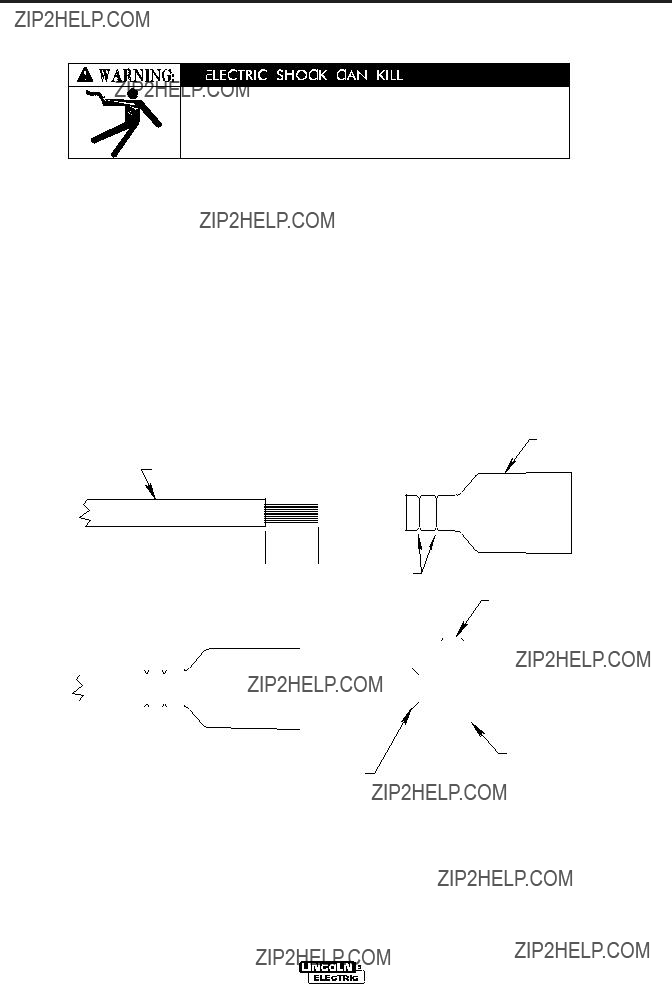
TWIST-MATE CABLE PLUG INSTALLATION INSTRUCTIONS
TWIST-MATE WELDING CABLE PLUG INSTALLATION INSTRUCTIONS
1.CHECK THAT THE CONNECTOR BOOT IS MARKED FOR THE
APPROPRIATE CABLE SIZE PER TABLE BELOW; AND
SKIN CABLE JACKET TO LENGTH SPECIFIED:
2.If necessary, trim cable end of boot at groove(s) to match cable diameter. Boot must fit tightly enough to seal around outside
diameter of cable. NOTE: Some boots are designed to accommodate
different cable diameters without trimming. These boots do not have grooves at the cable end. Soap or other non petroleum
based lubricant will help to slide the boot over the cable.
WELDING CABLE
SEE
 ABOVE
ABOVE 
TRIM
BRASS PLUG
COPPER TUBE
6.Tighten set screw(s) to collapse copper tube. Screw(s)
must apply firm pressure against welding cable. The top of the set screw(s) will be nearly flush or below the surface of the brass plug after tightening.
7.Slide rubber boot over brass plug. The rubber boot must be positioned to completely cover all electrical surfaces after the plug is locked into the receptacle.
Address: _______________________________________________
Name: _______________________________________________
Now Available...12th Edition
The Procedure Handbook of Arc Welding
With over 500,000 copies of previous editions published since 1933, the Procedure Handbook is considered by many to be the ???Bible??? of the arc welding industry.
This printing will go fast so don???t delay. Place your order now using the coupon below.
The hardbound book contains over 750 pages of welding information, techniques and procedures. Much of this material has never been included in any other book.
A must for all welders, supervisors, engineers and designers. Many welding instructors will want to use the book as a reference for all students by taking advantage of the low quantity discount prices which include shipping by 4th class parcel post.
$15.00 postage paid U.S.A. Mainland
How To Read Shop Drawings
The book contains the latest information and application data on the American Welding Society Standard Welding Symbols. Detailed discussion tells how engineers and draftsmen use the ???short-cut??? language of symbols to pass on assembly and welding information to shop personnel.
Practical exercises and examples develop the reader???s ability to visualize mechanically drawn objects as they will appear in their assembled form.
187 pages with more than 100 illustrations. Size 8-1/2??? x 11??? Durable, cloth-covered board binding.
$4.50 postage paid U.S.A. Mainland
New Lessons in Arc Welding
Lessons, simply written, cover manipulatory techniques; machine and electrode characteristics; related subjects, such as distortion; and supplemental information on arc welding applications, speeds and costs. Practice materials, exercises, questions and answers are suggested for each lesson.
528 pages, well illustrated, 6??? x 9??? size, bound in simulated, gold embossed leather.
$5.00 postage paid U.S.A. Mainland
Need Welding Training?
The Lincoln Electric Company operates the oldest and most respected Arc Welding School in the United States at its corporate headquarters in Cleveland, Ohio. Over 100,000 stu- dents have graduated. Tuition is low and the training is ???hands on???
and ask for bulletin ED-80 or call 216-383-2259 and ask for the Welding School Registrar.
Lincoln Welding School
5 weeks of fundamentals
There is a 10% discount on all orders of $50.00 or more for shipment at one time to one location.
Orders of $50 or less before discount or orders outside of North America must be prepaid with charge, check or money order in U.S. Funds Only. Prices include shipment by 4 th Class Book Rate for U.S.A. Mainland Only. Please allow up to 4 weeks for delivery.
UPS Shipping for North America Only. All prepaid orders that request UPS shipment please add:
For North America invoiced orders over $50.00 & credit card orders, if UPS is requested, it will be invoiced or charged to you at cost. Outside U.S.A. Mainland order must be prepaid in U.S. Funds. Please add $2.00 per book for surface mail or $15.00 per book for air parcel post shipment. METHOD OF PAYMENT: (Sorry, No C.O.D. Orders)
CHECK ONE:
Please Invoice (only if order is over $50.00)
USE THIS FORM TO ORDER:
BOOKS OR FREE INFORMATIVE CATALOGS
Lincoln Welding School
(ED-80)
Seminar Information
(ED-45)
Educational Video Information
(ED-93)
James F. Lincoln Arc Welding
Foundation Book Information
(JFLF-515)
Order from: BOOK DIVISION, The Lincoln Electric Company, 22801 St. Clair Avenue, Cleveland, Ohio 44117-1199
Telephone: 216-383-2211 or, for fastest service, FAX this completed form to: 216-361-5901.
Chinese
Korean
Arabic
READ AND UNDERSTAND THE MANUFACTURER???S INSTRUCTION FOR THIS EQUIPMENT AND THE CONSUMABLES TO BE
USED AND FOLLOW YOUR EMPLOYER???S SAFETY PRACTICES.
SE RECOMIENDA LEER Y ENTENDER LAS INSTRUCCIONES DEL FABRICANTE PARA EL USO DE ESTE EQUIPO Y LOS
CONSUMIBLES QUE VA A UTILIZAR, SIGA LAS MEDIDAS DE SEGURIDAD DE SU SUPERVISOR.
LISEZ ET COMPRENEZ LES INSTRUCTIONS DU FABRICANT EN CE QUI REGARDE CET EQUIPMENT ET LES PRODUITS A
ETRE EMPLOYES ET SUIVEZ LES PROCEDURES DE SECURITE DE VOTRE EMPLOYEUR.
LESEN SIE UND BEFOLGEN SIE DIE BETRIEBSANLEITUNG DER ANLAGE UND DEN ELEKTRODENEINSATZ DES HER-
STELLERS. DIE UNFALLVERH??TUNGSVORSCHRIFTEN DES ARBEITGEBERS SIND EBENFALLS ZU BEACHTEN.
Chinese
Korean
Arabic
LEIA E COMPREENDA AS INSTRU????ES DO FABRICANTE PARA ESTE EQUIPAMENTO E AS PARTES DE USO, E SIGA AS
PR??TICAS DE SEGURAN??A DO EMPREGADOR.
??? World's Leader in Welding and Cutting Products ???
??? Sales and Service through Subsidiaries and Distributors Worldwide ???
Cleveland, Ohio 44117-1199 U.S.A. TEL: 216.481.8100 FAX: 216.486.1751 WEB SITE: www.lincolnelectric.com


 WARNING
WARNING


 WELDING SPARKS can
WELDING SPARKS can 
 cause fire or explosion.
cause fire or explosion.

 CYLINDER may explode
CYLINDER may explode 





 if damaged.
if damaged.

 WARNING
WARNING CAUTION
CAUTION

 located on the base of the machine is provided for this purpose. See the National Electrical Code for details on proper grounding methods.
located on the base of the machine is provided for this purpose. See the National Electrical Code for details on proper grounding methods.
 WARNING
WARNING ") or the high inductance terminal (marked "
") or the high inductance terminal (marked " 
 ").
").

 WARNING
WARNING WELDING SPARKS
WELDING SPARKS 
 can cause fire or explosion
can cause fire or explosion
 CAUTION
CAUTION
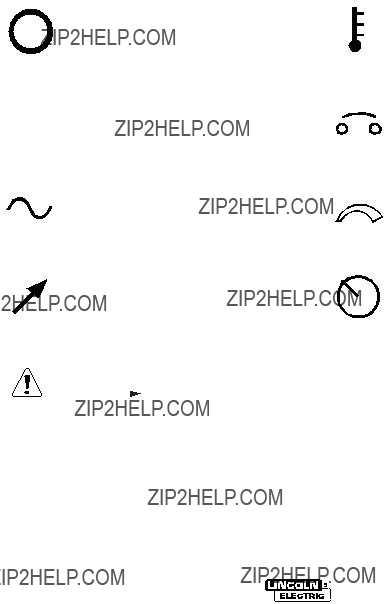
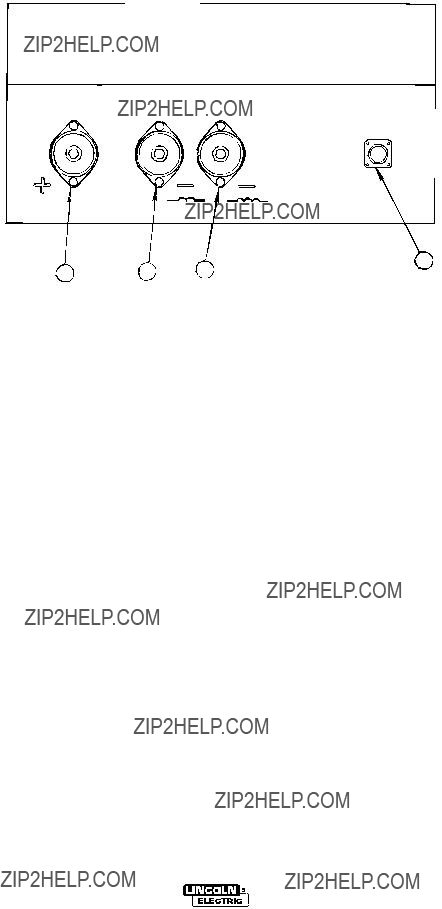

 CAUTION
CAUTION

 WARNING
WARNING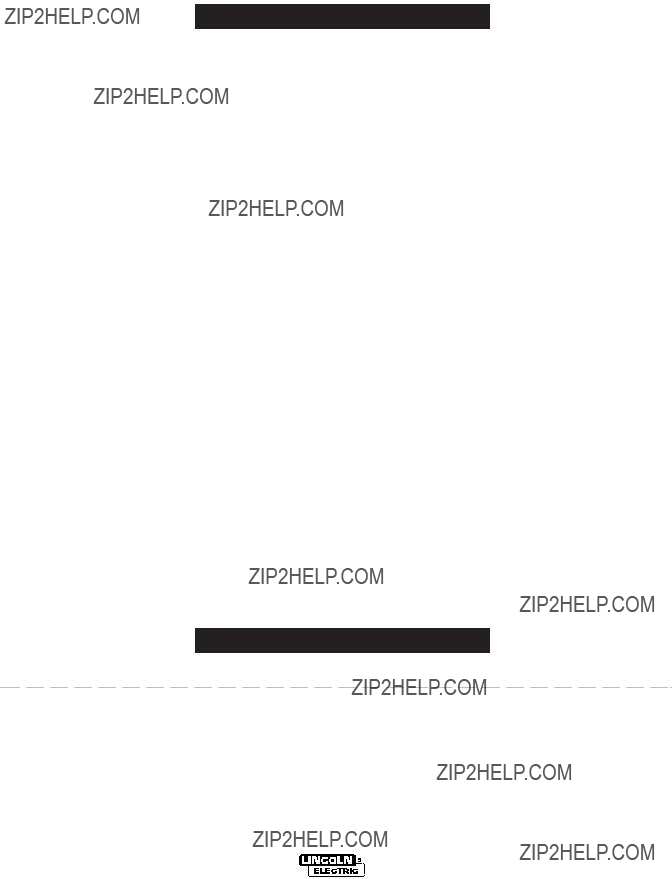
 WARNING
WARNING CAUTION
CAUTION
 CAUTION
CAUTION
 CAUTION
CAUTION
 CAUTION
CAUTION
 CAUTION
CAUTION
 CAUTION
CAUTION
 WARNING
WARNING CAUTION
CAUTION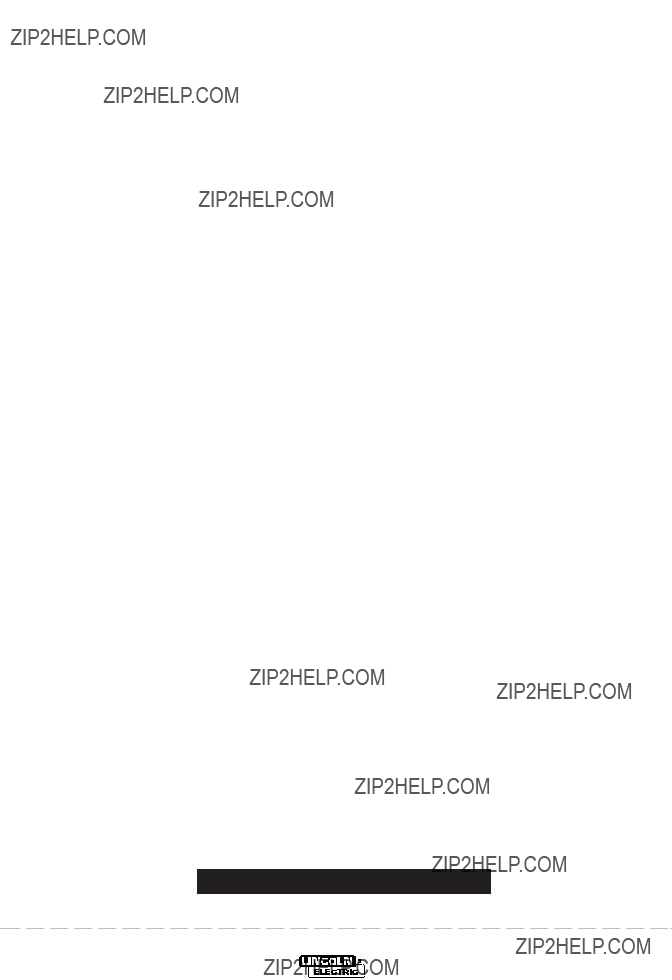
 CAUTION
CAUTION
 +
+





 12V O2 TOP
12V O2 TOP 42V O1 TOP
42V O1 TOP
 42A
42A 
 42
42
 Turn off input power to the Welding Power Source using the disconnect switch at the fuse box Before connecting the wire feeder.
Turn off input power to the Welding Power Source using the disconnect switch at the fuse box Before connecting the wire feeder.

 Turn off input power to the Welding Power Source using the disconnect switch at the fuse box Before connecting the wire feeder.
Turn off input power to the Welding Power Source using the disconnect switch at the fuse box Before connecting the wire feeder.
 Turn off input power to the Welding Power Source using the disconnect switch at the fuse box Before connecting the wire feeder.
Turn off input power to the Welding Power Source using the disconnect switch at the fuse box Before connecting the wire feeder.
 Turn off input power to the Welding Power Source using the disconnect switch at the fuse box Before connecting the wire feeder.
Turn off input power to the Welding Power Source using the disconnect switch at the fuse box Before connecting the wire feeder.


 N.D.
N.D.
 TO WORK
TO WORK
 Turn off input power to the Welding Power Source using the disconnect switch at the fuse box Before connecting the wire feeder.
Turn off input power to the Welding Power Source using the disconnect switch at the fuse box Before connecting the wire feeder.




 ABOVE
ABOVE 
